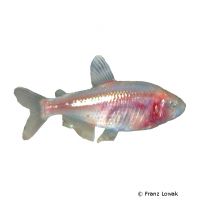Blind Cave Tetra (Astyanax jordani)
| Blind Cave Tetra Astyanax jordani | |
|---|---|
| Name | Blind Cave Tetra |
| Name Lat. | Astyanax jordani |
| Synonym | Astyanax fasciatus mexicanus |
| Family | Characins |
| Family lat. | Characidae |
| Order | Characins |
| Order lat. | Characiformes |
| Origin | Mexico |
| Habitat | Caves, caverns |
| Diet | Carnivore |
| pH | 6.5-8.0 |
| Behavior | Peaceful |
| Keeping | Group, school |
| Care Level | Easy |
| Reproduction | Egg scatterer |
| Breeding | Moderately difficult |
| Life Span | 4-7 years |
| Protection | No |
| Metric Units | |
| Size | 9 cm |
| Temperature | 18-23 °C |
| Hardness | 5-25 °dH |
| Aquarium | ~ 250 l |
| US Units | |
| Size | 3.5" |
| Temperature | 64-73 °F |
| Hardness | 89-445 ppm |
| Aquarium | ~ 60 gal |
Distribution and habitat
The distribution area of the blind cave tetra is Mexico. They live in lightless caves and caverns.
Maintenance
The aquarium should be structured with stones, caves and shelters and provide sufficient swimming space. Planting is not necessary. A dark substrate of coarse gravel and strongly darkened, diffuse light is ideal.
No ammonia, ammonium and nitrite should be detectable, the nitrate value should not exceed 100 mg/l. To ensure water quality and oxygen content, a filter adapted to the size of the aquarium and a heater are required.
Diet
In nature they feed mainly on insect larvae and plankton. The food supply consists of live, frozen and dry food. For a balanced diet, feed once a day with a high-quality, protein-rich dry food (flakes, granules, pellets) as well as cyclops, moina, daphnia, artemia, mosquito larvae, etc. (live or frozen)
It is recommended to feed small portions several times a day. Only feed as much as will be eaten within a few minutes. A regular and varied diet promotes health and increases resistance.
Behaviour and compatibility
These very peaceful schooling fish can be kept very well with other peaceful, not too lively fish in a community tank. They should be kept in a group of at least 5-10 fish.
Basically, only mutually compatible fish species with similar demands on water conditions and water temperature may be socialized
Sex dimorphism
The males are more slender than the more rounded appearing females.
Reproduction and breeding
They are free spawners and lay their eggs, up to 1,000 pieces, indiscriminately. The larvae hatch after about 24 hours and swim freely after 5-7 days. The parents do not engage in brood care and should be separated from the fry after spawning, as they are spawn predators.
Fry must be fed several times a day with special rearing food (Artemia nauplii). Breeding is hardly possible in community tanks, as the spawn is easy prey.
Important
They have adapted to a life in absolute darkness. Their blindness, the eyes are degenerated, is compensated by the well-developed lateral line organ and sensitive taste buds. This allows them to orient themselves well and they are also successful in foraging. The body color is largely flesh-colored, as the skin lacks pigmentation.
Presumably, the blind cave tetra (Astyanax jordani) evolved from its sighted, non-cave-dwelling sister species, the Mexico tetra (Astyanax mexicanus)
The well-being of the fish should be monitored regularly. Temperature should be checked daily, pH, hardness and nitrate levels at least every 14 days. Regular partial water changes are recommended, even if the contaminant level has not yet reached the upper limit. Sudden changes in water quality should be avoided. Newly introduced fish must be accustomed slowly to the water in the aquarium.
Further literature can be found in your pet store.
References
Verfasser: Werner Winter; Image: Franz Lowak
Source: BMEL (1998): Tierschutzgutachten - Haltung von Zierfischen (Süßwasser); RIEHL & BAENSCH (2006): Aquarien Atlas Bd. 1, Mergus Verlag; ENGELMANN (2005): Zootierhaltung - Tiere in menschlicher Obhut: Fische, Verlag Harri Deutsch
- Gemäß Tierschutzgesetz idgF
